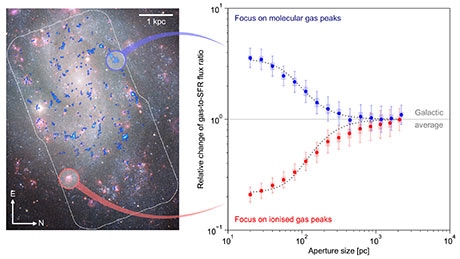May 23 2019
Inside interstellar clouds of dust and gas, or what are called molecular clouds, star formation progresses at a highly rapid rate yet it is highly “inefficient.” Stellar radiation scatters a major portion of the gas, indicating that galaxies are highly dynamic systems, such as “cosmic cauldrons,” formed of components that continuously change their appearance.
 The image on the left shows that the positions of molecular clouds (blue) and young stars (pink) do not coincide on small spatial scales. The two branches on the right quantify this displacement by showing that molecular clouds and young stars are correlated only when “averaged” over a large part of the galaxy (1,000 parsecs, corresponding to 3,000 light years). (Image credit: Diederik Kruijssen and Nature)
The image on the left shows that the positions of molecular clouds (blue) and young stars (pink) do not coincide on small spatial scales. The two branches on the right quantify this displacement by showing that molecular clouds and young stars are correlated only when “averaged” over a large part of the galaxy (1,000 parsecs, corresponding to 3,000 light years). (Image credit: Diederik Kruijssen and Nature)
A group of researchers headed by astrophysicist Dr Diederik Kruijssen from Heidelberg University used new observations of the NGC 300 spiral galaxy to reconstruct, for the first time, the time-evolution of molecular clouds and the process of star formation inside them. Their investigation reveals that these clouds are short-lived structures that undergo rapid lifecycles, induced by the intense radiation from the new-born stars. The study outcomes have been reported in the journal Nature.
The detected star formation intensity in the NGC 300 spiral galaxy can be described in two ways. Molecular clouds may be very long-lived and ultimately transform all of their mass into stars. Here, the young stars’ positions should normally match those of the molecular clouds from which they formed.
By contrast, stars may form at a very rapid rate inside molecular clouds and scatter the gas with their intense radiation, resulting in only a small fraction of the gas being transformed into stars. Here, molecular clouds and young stars should normally dwell in different locations.
In order to determine which of the models is accurate, Dr Kruijssen and his colleagues integrated two different sets of observations of the NGC 300 galaxy, which is nearly six million light-years away from the Milky Way. A map of light emitted by carbon monoxide is the first observation, which reveals where molecular clouds dwell. The second one is a map of hot, ionized hydrogen, marking the positions of newly formed, massive stars.
The Atacama Large Millimeter Array (ALMA) of the European Southern Observatory (ESO) and the 2.2-meter telescope of the Max Planck Society and ESO were used for obtaining these maps. The ALMA observations were performed by Dr Andreas Schruba, scientist at the Max Planck Institute for Extraterrestrial Physics in Garching and one of the co-authors of the study.
The researchers used a new statistical technique to investigate the data, which involves determining how molecular gas and star formation in galaxies are interlinked on various spatial scales. For the first time, this technique has allowed precise quantification of the positions of molecular clouds and young stars in relation to each other.
The researchers note that the outcomes reveal without a doubt that the positions of molecular clouds and young, massive stars hardly coincide. This effect is more pronounced on smaller scales. The researchers came to a conclusion that stars form at a very rapid rate, such that gas and young stars represent unique, subsequent phases in the lifecycle of molecular clouds.
Our findings demonstrate that star formation proceeds very rapidly and highly inefficiently. Molecular clouds in NGC 300 live for about ten million years and take only about 1.5 million years to be destroyed, well before the most massive stars have reached the end of their lives and explode as supernovae.
Dr Diederik Kruijssen, Research Group Leader, Institute for Astronomical Computing, Heidelberg University
The intense radiation from young stars disperses their parent molecular cloud by heating it and dispersing it in the form of hot interstellar gas bubbles. This way, only two to three percent of the mass in molecular clouds is actually converted into stars.
Dr Mélanie Chevance, Study Co-Author, Heidelberg University
Chevance is one of the researchers in Kruijssen’s team.
Currently, the research team intends to apply the new statistical technique for observations of very distant galaxies to understand how star formation progressed in molecular clouds across the history of the Universe.
We will now proceed to investigate the relation between molecular clouds and young stars in galaxies throughout the cosmos. In the near future, this will allow us to understand galaxies as collections of components that undergo star formation-driven lifecycles and together shape the appearance of their host galaxies.
Dr Diederik Kruijssen, Research Group Leader, Institute for Astronomical Computing, Heidelberg University
The study was performed in cooperation with scientists from the United Kingdom, the United States, and the Netherlands. The German Research Foundation (DFG) and the European Research Council (ERC) funded the study.
Anti-correlation between molecular clouds and young stars in the nearby galaxy NGC300
The video demonstrates that molecular clouds (top right) and young stars (top left) are anti-correlated in the nearby NGC 300 galaxy. As the video plays, the spatial resolution increases and the ratio between molecular clouds and young stars (bottom left) changes from white (strong correlation) on large scales to bright red and blue (strong anti-correlation) on small scales. The graph in the bottom-right panel quantifies this behavior. (Video credit: Diederik Kruijssen and Nature)